How you can use this image
This image can be used for non-commercial research or private study purposes, and other UK exceptions to copyright permitted to users based in the United Kingdom under the Copyright, Designs and Patents Act 1988, as amended and revised. Any other type of use will need to be cleared with the rights holder(s).
Review the copyright credit lines that are located underneath the image, as these indicate who manages the copyright (©) within the artwork, and the photographic rights within the image.
The collection that owns the artwork may have more information on their own website about permitted uses and image licensing options.
Review our guidance pages which explain how you can reuse images, how to credit an image and how to find images in the public domain or with a Creative Commons licence available.
Notes
Add or edit a note on this artwork that only you can see. You can find notes again by going to the ‘Notes’ section of your account.
A night-time view showing an eyewitness account of the Great Comet of 1843, painted by the astronomer Charles Piazzi Smyth. The earliest observation occurred on the evening of 5th February, 1843 and Smyth recorded its appearance at the Royal Observatory, Cape of Good Hope, South Africa between 3rd and 6th March. When at its greatest brilliance, it was visible only from southern latitudes. The view in the painting is probably taken from the Observatory. It shows Table Bay with Table Mountain visible in the background on the left. A large sailing ship sits in the foreground on the right, with other shipping in the distance. Since the main purpose of the painting was to show the comet, the sky dominates the image. The comet formed a disk and Smyth described its nucleus as 'a planetary disk, from which rays emerged in the direction of the tail'. He observed that to the naked eye it appeared to have a double tail, with the two streamers proceeding from the head in perfectly straight lines. The tail of the comet holds the record for actual extent and the sighting was notable because of the intensity of light, apparently outshining any comet seen in the previous seven centuries, as well as for the length of its tail. The painting shows the dramatic effect of the phenomenon, and the brilliance of the stars and red of the sunset continues this.
Smyth was an astronomer, geodesist, spectroscopist, meteorologist, pyramidologist, photographer, traveller and writer. He realised that cities were not the ideal place for astronomical observations and fought for the settlement of observatories on mountains. As one of the great British astronomers, he was 42 years Astronomer Royal for Scotland.
Title
The Great Comet of 1843
Date
1843
Medium
oil on canvas
Measurements
H 90.7 x W 61 cm
Accession number
BHC4148
Work type
Painting




